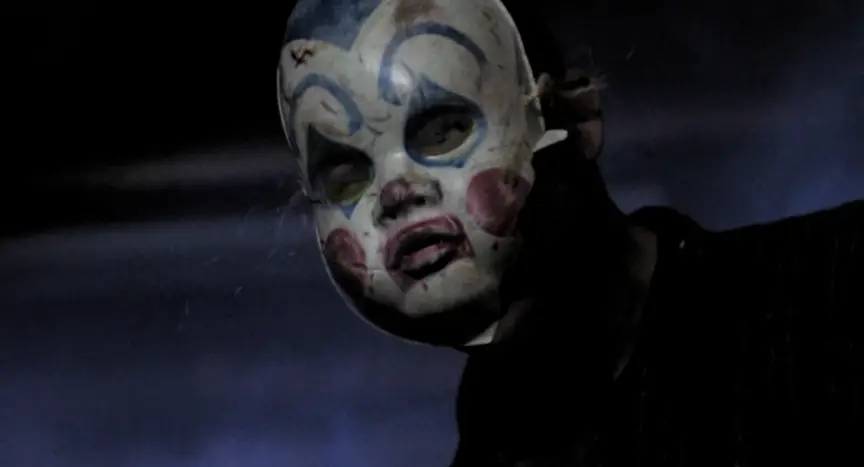Jamie Lee Curtis could scream. Whether you’re a fan of Halloween, Prom Night, The Fog, or any other horror project she’s graced with her presence, we can all admit Curtis’ shrieks were bloodcurdling. They made her films better, more believable. In her directorial debut, Don’t Look, Luciana Faulhaber casts herself as a character who screams repeatedly, but she doesn’t have the abandon to be believable. Faulhaber sounds as though she’s constantly holding back, breaking the illusion of the film, but consistently puts herself in positions where she’s screaming again and again.
Related: 17 of the Most Memorable Scream Queens in Horror
Don’t Look boasts that it is a “slasher throwback,” though it feels more mid-90s than 80s heyday. The premise sees five friends traveling to a remote cabin that belongs to Nicole (Lindsay DiFulvio, now Lindsay Eshelman) for Thanksgiving. Her parents were shot to death in this very cabin, as we see in an orange-tinted flashback that kicks off the movie. About halfway through, a killer that hasn’t been previously hinted at starts picking them, and two other rustic tenants, off one by one.
The rest of the actors struggle in their roles as much as Faulhaber does. They deliver their lines woodenly, and frequently remind the audience that they are, in fact, pretending. It’s hard to tell whether the problem was the acting or the script, which calls for the rustic tenant to introduce his significant other as, “This sweet potato here” and considers, “So, Ted, would you like to get some firewood with me?” flirting.
The script for Don’t Look struggles with repetitiveness. Alex (Curtis K. Case) talks about his inability to get signal on his phone repeatedly in the first half of the movie. He’s not trying to call or text anyone in particular, but that doesn’t stop him from checking how many bars he has again and again. There’s no motivation for him to do that except to let the audience, which he presumably doesn’t know about as a character in a film, know that no one can call for help.
Writers Jessica Boucher and Danielle Killay also don’t seem to think through the reality of the situation. Stories don’t necessarily require everything to be totally realistic in order to function, but there needs to at least be some consistency. Sebastian (Javier E. Gómez) is very happy that they remembered to turn the power on in the farmhouse, but the house is very clean, lived-in. Has someone been mopping in the dark?
Likewise, the current tenants have done a tremendous amount of hunting, too much to also be running the Christmas Tree section of the farm, which looks almost functional minus workers on Thanksgiving weekend. It’s at least functional enough to have working gear strewn everywhere. I’ve never been on a farm, but I imagine that at the end of the day, tools like axes and a Christmas Tree wrapping machine(!) wouldn’t be left laying around to weather the elements (or be grabbed by an opportunistic murderer).

As little consideration has been given to these kinds of details, even less was given to the character’s motivations for the things that they do. After she figures out what’s going on, Lorena (Faulhaber) stacks every gun and knife in the house on the coffee tables and proceeds to leave them there. Characters can make mistakes. They can do stupid things. But there has to be consequences. For forgetting or willfully leaving a loaded gun when a slasher is after you, there needs to be some fallout, but the movie forgets about the stockpile as well as everything else.
The killer has an interesting character design — a cut off doll’s face over his own — but he’s barely shown, and when he is, it’s quick glimpses, so we can never fully appreciate the effect. There’s never the comparative money shot of him that catapulted Halloween and Friday the 13th to cultural relevance decades after they were first released: him standing center frame, seven feet tall and walking slowly after his victim. The unnamed (as far as I could tell from watching the film) killer is an afterthought. The film is also missing POV shots, which may be a stylistic choice but doesn’t exactly help its case as a slasher throwback.
See Also: Netflix Horror Spotlight: Slasher, Season 2
What Don’t Look kept from those slashers, instead, is the sex-negative attitude and the leery, straight male gaze. There are close ups of every woman’s chest and two out of the three named female characters are filmed running in bras and underwear or less. Characters who have sex are punished. For a director who claimed, “It was important for me to create work that shows the female characters as they are in real life – none of us are waiting to be saved by some prince charming,” the straight male gaze, female nudity vastly outnumbering male nudity (to the film’s credit, it does feature one guy’s butt) and sex negativity feel incredibly out of place.
The highlight of Don’t Look is that it was only 71 minutes long but, regardless, avoid at all costs and stick to the actual classic slashers rather than some pretender to the throne.
Wicked Rating: 3/10
Director: Luciana Faulhaber
Writers: Jessica Boucher, Danielle Killay, Luciana Faulhaber (story)
Stars: Luciana Faulhaber, Jeff Berg, Jarrod Robins, Javier E. Gómez, Curtis K. Case, Lindsay Eshelman
Release: May 14, 2019
Language: English
Length: 71 minutes
Sub-genre: Slasher

